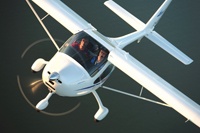German Aircraft Co. Lands Assembly Facility in Rogers
by April 7, 2008 12:00 am 117 views

In the last three years, the friendly skies were populated with fewer private pilots than at any time since 1966.
Remos Aircraft GmbH, of Germany, recently opened an assembly facility in Rogers and is among the manufacturers making it easier and more affordable than ever to take wing.
The company’s G-3 — which retails for between $115,000 and $120,000 — is in a relatively new class of planes called light sport aircraft.
In 2005, the Federal Aviation Administration announced the sport pilot certification, which has fewer restrictions than a private pilot’s license, and was created to complement LSA.
The certification of aircraft and license are “two pieces of same puzzle,” said Chris Dancy, a spokesman with the Aircraft Owners and Pilots Association, based in Frederick, Md.
Remos manufactures the parts for its planes in Germany and then ships them to the Rogers facility to be assembled. The company has had a presence in the United States since 2006.
This is logical for Remos, because 80 percent to 85 percent of the market for LSA is in the United States, said CEO Michael Meirer. He emphasized that Remos planes are of the highest quality German craftsmanship.
The company has sold about 250 of its G-3s. The planes run on gasoline instead of the more expensive aviation fuel that powers other small aircraft, thus reducing operating expenses for owners.
In 2007, there were 600 LSA sold across the country. Meirer expects that number to increase to about 3,000 a year by 2012.
That estimation seems likely given the rapid increase in the number of sport licenses issued by the FAA.
According to the administration, 134 people earned the certification in 2005. That shot up to 939 in 2006 and more than doubled to 2,031 in 2007. Dancy said the growth would most likely continue in 2008 and beyond.
Remos is in a good position to capitalize on this expanding market. Dealers in several states sell the G-3, including California, Missouri, Oklahoma, Texas and Arizona, among others. The company chose Rogers for its assembly operation because of the city’s location.
“It’s very centrally located, with great facilities all around, including transportation,” Meirer said.
Three people work at the Rogers location, assembling about four to five planes a month, but that will be increasing significantly over the coming months and Remos will likely hire more staff, Meirer said.
Part of the reason for classifying the aircraft type and creating a new license to accompany it was to attract more people to flying, Dancy said.
In 1980, there were 357,479 private pilots in the country. By 2004, the year before the sport pilot license was initiated, there were 235,994, a 34 percent decrease.
To earn a sport pilot license, a pilot must complete 20 hours of flight time as opposed to 40 hours for a private pilot’s license.
The medical requirement for sport pilots is also less restrictive than for private pilots. A valid driver’s license is the only document necessary to prove a pilot’s health. This means that many former pilots who are no longer eligible for a private pilot’s license can fly once again, albeit with some limitations.
Sport pilots can only operate LSA and other similar qualifying planes with a pre-takeoff weight of less than 1,320 pounds, and cannot fly at night, in bad weather, above 10,000 feet or farther than a 50-mile radius.
They can only carry one passenger and cannot charge money for flying. But if a sport pilot wants to pursue a private pilot’s license, all of the prior flight hours and training will count toward that designation, provided the pilot passes extra medical and training requirements.
“That’s one of the hopes, that the sport pilot license will draw in people who might have been put off by the cost or time it takes to earn a private pilot’s certificate,” Dancy said.
